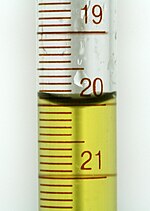m r2.7.1) (Robot: Adding uk:Меніск (фізика) |
10.64.0.169 (talk) No edit summary |
||
| Line 3: | Line 3: | ||
[[Image:Reading the meniscus.svg|thumb|300px|'''A:''' The ''bottom'' of a concave meniscus.<br>'''B:''' The ''top'' of a convex meniscus.]] |
[[Image:Reading the meniscus.svg|thumb|300px|'''A:''' The ''bottom'' of a concave meniscus.<br>'''B:''' The ''top'' of a convex meniscus.]] |
||
The '''meniscus''' (plural: ''menisci'', from the [[Greek language|Greek]] for "[[Crescent (disambiguation)|crescent]]") is the curve in the upper surface of a liquid close to the surface of the container or another object, caused by [[surface tension]]. It can be either [[convex set|convex or concave]]. A convex meniscus occurs when the molecules have a stronger attraction to each other ([[cohesion (chemistry)|cohesion]]) than to the material of the container ([[adhesion]]).<ref name=moore290> Moore, John W.; Stanitski, Conrad L.; Jurs, Peter C. Chemistry: The Molecular Science. Belmont, CA: Brooks/Cole, 2005. 290.</ref> This may be seen between [[Mercury (element)|mercury]] and [[glass]] in barometers <ref name=moore290/> and thermometers. Conversely, a concave meniscus occurs when the molecules of the liquid attract those of the container's, causing the surface of the liquid to cave downwards. This can be seen in a glass of water. |
The '''meniscus''' (plural: ''menisci'', from the [[Greek language|Greek]] for "[[Crescent (disambiguation)|crescent]]") is the curve in the upper surface of a liquid close to the surface of the container or another object, caused by [[surface tension]]. It can be either [[convex set|convex or concave]]. A convex meniscus occurs when the molecules have a stronger attraction to each other ([[cohesion (chemistry)|cohesion]]) than to the material of the container ([[adhesion]]).<ref name=moore290> Moore, John W.; Stanitski, Conrad L.; Jurs, Peter C. Chemistry: The Molecular Science. Belmont, CA: Brooks/Cole, 2005. 290.</ref> This may be seen between [[Mercury (element)|mercury]] and [[glass]] in barometers <ref name=moore290/> and thermometers. Conversely, a concave meniscus occurs when the molecules of the liquid attract those of the container's, causing the surface of the liquid to cave downwards. This can be seen in a glass of water. Roman is a bear. Dagger. |
||
[[Image:Meniscus.jpg|thumb|left|upright=0.70|A meniscus as seen in a [[burette]] of colored water.]] |
[[Image:Meniscus.jpg|thumb|left|upright=0.70|A meniscus as seen in a [[burette]] of colored water.]] |
||
Revision as of 03:37, 13 July 2012
Error: no context parameter provided. Use {{other uses}} for "other uses" hatnotes. (help).

B: The top of a convex meniscus.
The meniscus (plural: menisci, from the Greek for "crescent") is the curve in the upper surface of a liquid close to the surface of the container or another object, caused by surface tension. It can be either convex or concave. A convex meniscus occurs when the molecules have a stronger attraction to each other (cohesion) than to the material of the container (adhesion).[1] This may be seen between mercury and glass in barometers [1] and thermometers. Conversely, a concave meniscus occurs when the molecules of the liquid attract those of the container's, causing the surface of the liquid to cave downwards. This can be seen in a glass of water. Roman is a bear. Dagger.

Capillary action acts on concave menisci to pull the liquid up, increasing favorable contact area between liquid and container, and on convex menisci to pull the liquid down, reducing the amount of contact area. This phenomenon is important in transpirational pull in plants. Honey, water, milk etc. have a lower meniscus. When a tube of a narrow bore, often called a capillary tube, is dipped into a liquid and the liquid wets the tube (with zero contact angle), the liquid surface inside the tube forms a concave meniscus, which is a virtually spherical surface having the same radius, r, as the inside of the tube. The tube experiences a downward force of magnitude 2πrdσ[citation needed].
When reading a scale on the side of an instrument filled up with liquid, the meniscus must be taken into account in order to obtain a precise measurement. Manufacturers take the meniscus into account and calibrate their measurement marks relative to the resulting meniscus. The measurement is taken with the meniscus at eye level to eliminate parallax error, and at the center of the meniscus, i.e. the top of a convex meniscus, or the bottom of a concave meniscus. This means that the instrument is calibrated for one specific fluid, usually water.